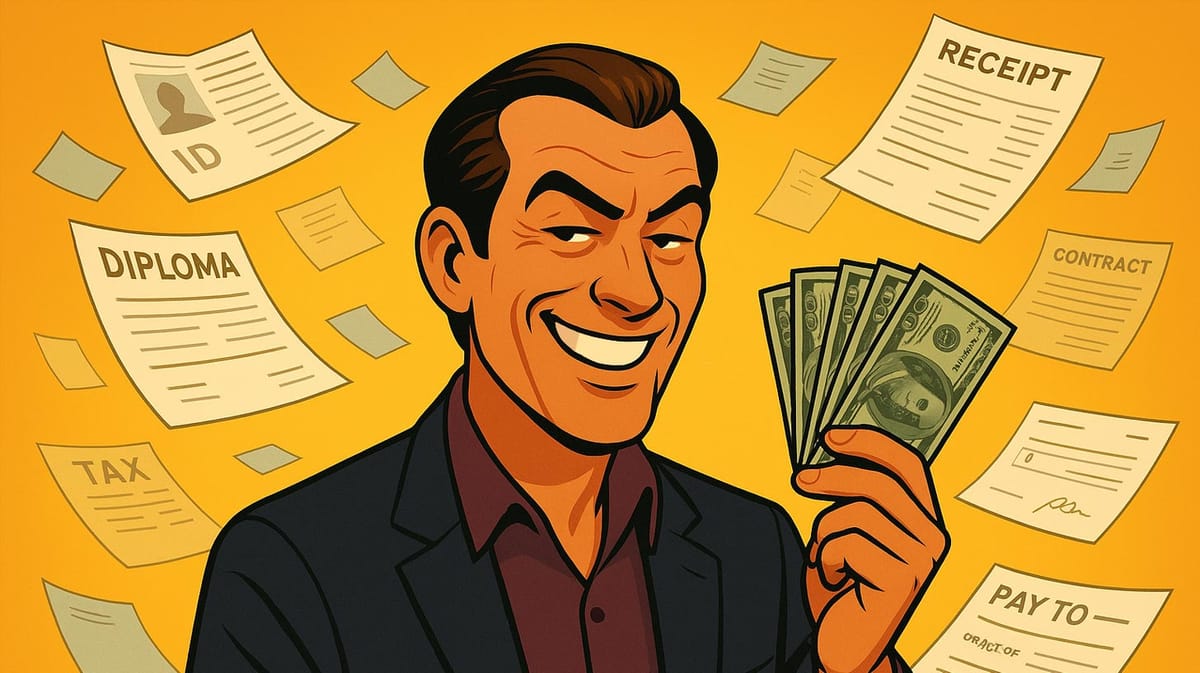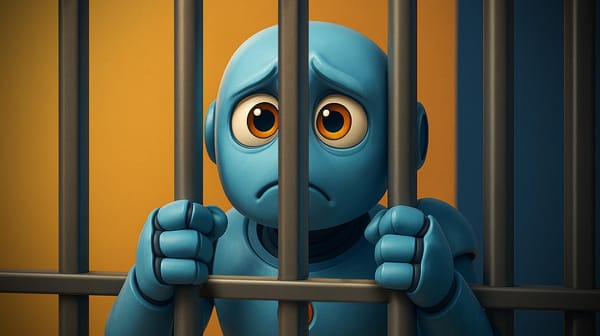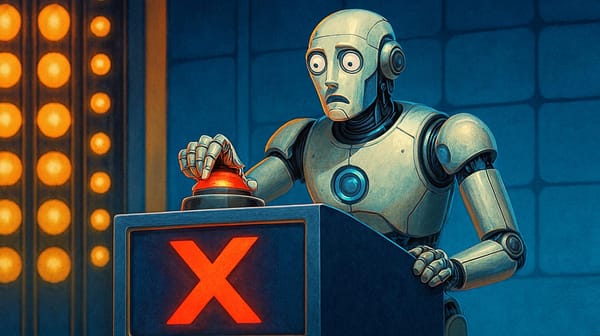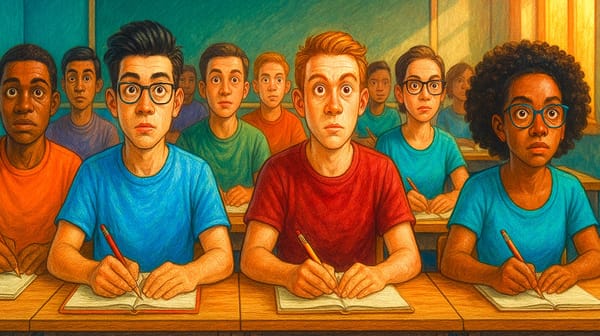Welcome to The Golden Age of Fraud
With ChatGPT's powerful new image generator, Ghibli-fication is just the tip of the iceberg.

Last week, the internet exploded with excitement over the latest OpenAI release: ChatGPT-4o image generation. People rushed in droves to create whimsical, Studio Ghibli–inspired fantasies and share them everywhere from TikTok to LinkedIn, X, and beyond. Within hours, rumors swirled that OpenAI’s GPU servers buckled under the sudden load—an early sign of just how voracious the public appetite for AI-driven imagery has become.
Yet, for all the debate about pirated art styles and copyright infringement, I felt like there was a bigger story unfolding. A story about the far-reaching, potentially devastating ways that AI-generated images can be weaponized. The lawsuits and debates around intellectual property are, in a sense, a convenient decoy. And everyone’s understandably focused on that bright, burning issue. But meanwhile, I can't help but wonder if we're entering The Golden Age of Fraud.
Let’s revisit the opening scene. ChatGPT’s image generation feature drops, and virtually overnight, tens of millions of images are produced. Memes, anime mashups, pop-culture parodies... an endless scroll of creative output. Naturally, the spotlight gravitates toward outraged artists, many who (rightly) accuse OpenAI of training on their work without consent. Others worry about the fate of authentic, human-crafted art. Not to mention literature (all of this on the heels of allegations that Meta used pirated books to train their models). Lawyers, think tanks, and social media pundits are all pointing fingers and fanning the flames.
But back to my question. Is all of this masking a far bigger story? If the worst we could do with generative AI was produce unauthorized artwork, we might count our blessings. The technology’s true capabilities have much darker potential. AI leaders like OpenAI’s Sam Altman hint that progress is unstoppable and appear more interested in forging ahead than in placing guardrails. Vague usage restrictions and regulatory bickering only bolster the notion that we're not prepared for what comes next.
The Allure of Unfettered AI
Every technological leap raises ethical concerns—think of the printing press or the early internet. Yet history has shown these moral quandaries often distract from the more immediate threats. Consider one small anecdote: within hours of ChatGPT’s image update, anonymous users reported using the system to generate eerily convincing sales receipts. A TechCrunch piece titled “ChatGPT’s New Image Generator Is Really Good at Faking Receipts” soon followed. In the blink of an eye, these fraudulent documents could be integrated into expense reports or insurance claims. That’s not just a neat party trick. It’s a massive liability for businesses and taxpayers alike. What would happen if this spread half as quickly as Ghibli-fication? Maybe it already has.
We’ve been promised a revolution in creativity. An age of effortless abundance. Sam Altman’s stance is that AI is inevitable, unstoppable, and beneficial if managed well. Critics worry that, in practice, this translates to “we’ll fix it later.” The vibe feels akin to the early days of social media, when platform founders encouraged growth first, only to scramble much later to handle misinformation, data breaches, and political manipulation. If the pattern holds, we might be watching the first domino of an even more complex chain reaction.
A Scammer's Paradise
To grasp the scale of the threat, consider just a sampling of what’s possible when a simple prompt is all it takes to forge, fake, fool, falsify, or fabricate:
Falsified Financial Documents
We’ve already seen how easy it is to fake receipts, thanks to the TechCrunch coverage. This quickly expands to include bank statements, checks, invoices—each more sophisticated than the last. For criminals, that’s a goldmine of new scams.
Counterfeit IDs and Credentials
AI-generated headshots are stunningly real. Combine that with an employee’s name and forged security badges, and you have a recipe for impersonation, corporate espionage, or serious security risk. The days of amateur fake IDs are over.
Phony Legal Evidence
Personal injury claims, staged car accidents, or “accidents” at the workplace—AI can fabricate photographic proof that may fool insurance companies or even tip the scales in court. How quickly can our legal system adapt to a new wave of unverifiable evidence?
Blackmail and Smear Campaigns
Public figures, politicians, and regular folks are all vulnerable. Compromising images can now be conjured from thin air and spread within minutes on social media. Even if proven false later, the damage might be irreversible.
Fake Social Proof in Marketing
Picture glowing “customer” testimonials with fabricated photos praising a new gadget. Maybe your brand won't go there, but will your competitors? Combine that with AI-generated influencers or fabricated endorsements, and one can sway public opinion—or defraud investors—almost effortlessly.
And this is just still images we’re talking about. Video generation, voice clones, and other tools are introducing an entirely new dimension for potential abuse, further complicating how we verify what’s real and what’s manufactured.
Why Policing This Will Be Nearly Impossible
Sheer Volume and Speed
OpenAI’s GPU meltdown story isn’t just a footnote. It’s a testament to how popular these tools are. When millions of AI-generated images flood the internet, how do you separate real from fake? Even more to the point, who has the bandwidth to try?
Digital Watermarks & Metadata
Developers tout watermarking or embedding metadata as a line of defense. Metadata is easy to strip. And watermarks can be blurred or cropped out. Heck, just ask ChatGPT to do it. It’s a classic cat-and-mouse game, each new detection method spawning an even better evasion tactic.
Technical Challenges
Detection algorithms also rely on machine learning, which can be fooled by advanced generative models. The deeper these models go—teaching themselves textures, lighting, and perspective—the harder it becomes to pinpoint their synthetic origin.
Jurisdictional and Legal Quagmires
The lawsuits targeting AI companies for copyright infringement may be the tip of the iceberg. Different countries will have wildly differing stances on AI usage, data ownership, and digital forgery. These are speed bumps at best, as no global, enforceable standard exists. And if Meta’s alleged unauthorized training on pirated books is any indicator, the tech heavyweights aren’t exactly holding themselves to lofty ethical standards.
The Marketer’s Dilemma
For marketers and brands, the promise of AI imagery is tantalizing. Rapid, on-demand visuals can power quick-turnaround campaigns and content creation at scale. But there’s a creeping sense of unease. If everything can be faked, does real brand authenticity lose meaning?
How valuable is honesty in the AI Era? A brand that chooses to remain fully transparent—labeling AI-generated visuals, resisting the urge to replicate copyrighted material or overstep bounds with IP—might earn consumer trust. Or they might find themselves outmaneuvered by competitors who embrace deception.
How tempting will it be to cut corners? AI can conjure “testimonials” that look like your ideal customer praising your product. For a company chasing quarterly numbers, that short-term advantage might be too much to resist. Yet one well-documented scandal can unravel a reputation built over decades.
Will we care about long-term consequences? Consumers aren’t naïve forever. If they suspect they’re being sold illusions, skepticism could become the norm, eroding the power of marketing altogether. In the same way AI giants seem to be cruising ahead, unafraid of repercussions, many in the marketing industry might follow their example. But is that wise? Or morally justifiable?
We’ve come to a tipping point, where images are no longer reliable proof of anything. Sam Altman’s public stance that AI progress “cannot be stopped” underscores the urgency of this moment. If the unstoppable force is upon us, what does that say about accountability? Are we collectively entering an era of self-policing, reliant on individual ethics in a space where wrongdoing is so easily concealed?
In the grand sweep of technological innovation, each breakthrough—be it the printing press or the internet—demanded new ethics, new laws, new ways of trusting one another. We’re at that crossroads again. The difference now is that the illusions are more convincing, and they come at us faster than ever. Those who move first, whether with good intentions or underhanded ambitions, set the tone for everyone who follows.
Now What?
Copyright debates may dominate headlines, but they’re just the opening skirmish. The real war is about our collective capacity to believe what we see. With AI-generated images proliferating, we risk living in a world where deception is frictionless.
So, what happens next?
Even if the courts come down with rulings against AI companies, it’s unlikely to stop the flood of new features or quell the user demand. This isn’t just about protecting artists’ rights, important though that is. It’s about safeguarding the very fabric of trust in our digital society. If the big AI players continue forging ahead without comprehensive safeguards, the responsibility may fall to individual users, marketers, and communities to uphold honesty.
And that is the ultimate question: Will we, as individuals and organizations, hold ourselves accountable to a higher standard, or will we succumb to the easy allure of forgeries and shortcuts? If this is indeed The Golden Age of Fraud, the honor system might be all we have left. And whether we choose to honor it or not could define the shape of the online world for years to come.






